This was published 1 year ago
Is this Australia’s most popular and heartbreaking love story?
Tom Conroy and Danny Ball are sitting next to each other in Belvoir’s upstairs rehearsal space. The stage is cluttered with 1970s sofas – the kind with the striped brown and beige knobbly fabric – as they rehearse for the company’s production of Holding the Man.
They are working through a scene in the first half of the play where they are discussing their characters’ possible break-up – should their chairs be facing each other? Should they be sharper with their dialogue? Even for the 15 minutes I watch, it’s hard seeing two people break up over and over again, particularly if you know what’s coming.
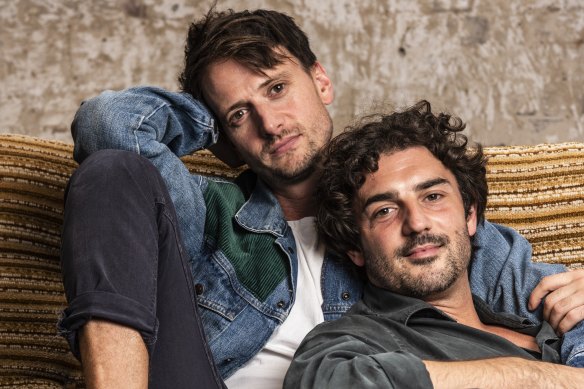
Tom Conroy and Danny Ball. Tom and Danny star in Holding the Man, one of Australia’s great love stories.Credit: Steven Siewert
“The first half is so joyous,” says Ball. “There’s so much love, joy and discovery that even as we’re finishing the first half, part of me is like, ‘Oh, no, I want to stay like this.’”
The play is an adaptation of Timothy Conigrave’s funny, tender and heartbreaking 1995 memoir and tracks the highs and lows of his 15-year love affair with John Caleo, who he met when they were students at an all-boys Jesuits school in Melbourne in the 1970s.
It follows their relationship from the moment a teenage Conigrave boldly asks Caleo, “Will you go round with me?” through to their 20s, when they move to Sydney, where they are both diagnosed with HIV in 1985.
The book was published three years after Conigrave died and adapted by playwright Tommy Murphy soon after. Its 2006 production at Griffin became such a critical and box-office success, it transferred to the Sydney Opera House and then Belvoir, with tours to Brisbane and Melbourne, followed by a limited run on London’s West End. Murphy then adapted the story again for the 2015 film, starring Ryan Corr, Craig Stott and Sarah Snook.
It is, in short, a classic – one of our greatest love stories that will make you laugh and cry and then cry some more with the kind of heaving sobs that you need time to recover from.
“It’s a great love story because it’s honest,” says Murphy, who has been sitting in on rehearsals. “Tim does this miraculous thing as a memoir writer, in that he lets John have the moral authority.
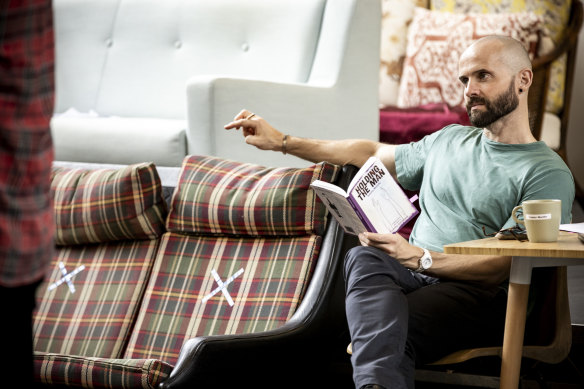
Playwright Tommy Murphy watches rehearsals of Holding the Man at Belvoir.Credit: Brett Boardman
“I can imagine writing a memoir, you might want to talk yourself up – you can imagine the self-promoting tendency of a memoir writer – but Tim admits his failings and admits his struggles and his shortcomings. And I think because of that, reading the book, you really trust the storyteller.”
But it’s also being revisited at a time that’s very different from when Tim and John lived, even from when the memoir was published. Last year marked the 40th anniversary of the first Australian person dying from AIDS, while in the 1980s about 50 per cent of people who contracted the virus died. Now, thanks to antiretroviral therapy, HIV is manageable and not the death sentence it once was. There are even drugs available to lower the risk of contracting HIV in the first place.
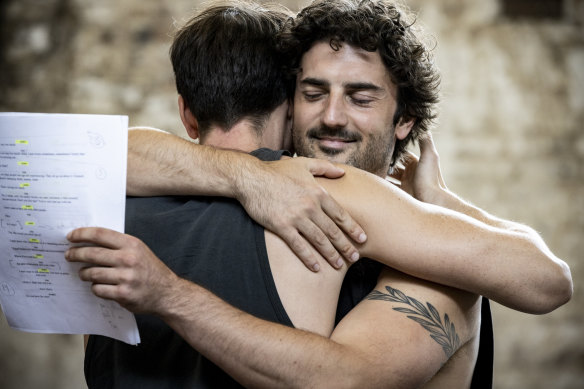
Danny Ball hugs Tom Conroy during rehearsals for Holding the Man at Belvoir.Credit: Brett Boardman
“When it first premiered as a play, it felt like very, very recent history,” says the play’s director Eamon Flack. “Whereas now, it feels like cultural memory. And I think it’s as much a story of how Australia has changed as to how these two men live their lives.
“It seemed a really interesting way to revisit the cultural story of Australia in the ’70s and ’80s and ’90s, through the lives of two gay men, rather than [doing] just a piece about life and death.”
For Murphy, that shift in how HIV/AIDs is treated and even prevented still feels personal.
“I take a blue tablet [Pre-exposure prophylaxis, or PrEP, medication] every day,” says Murphy. “And that protects me against HIV and even that is an extraordinary shift. That must have felt like a far-off dream and at one point. So there’s a great privilege that comes from the battles that were fought here, very near here in this suburb in Darlinghurst, the battles that were won.
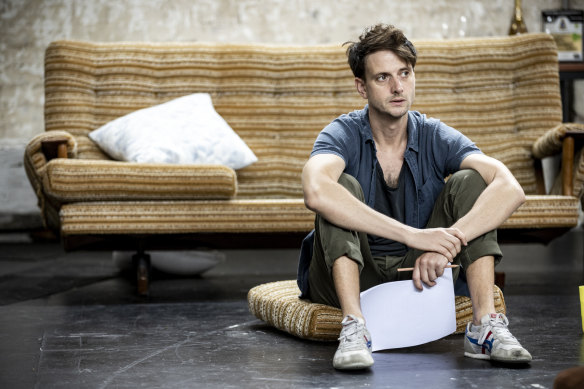
Tom Conroy plays Timothy Conigrave, the author of the memoir on which the play is based, in Holding the Man.Credit: Brett Boardman
“So I think the play in that way, looks at history and celebrates heroism. And it’s also a universal story about the nature of love and honesty and heartbreak.”
Getting that love, honesty and heartbreak right falls on Conroy and Ball’s shoulders. Conigrave and Caleo’s relationship was not always easy.
“He changes a lot,” says Conroy, who plays Tim from age nine to his early 30s. “He’s obviously a kid with a lot of energy, ambition, enthusiasm for life, and adventure and newness. And I think those qualities are what leads him on to some really amazing new experiences and they’re also the things that kind of get him in trouble along the way.”
That zest for life also opens up John’s world.
“John’s got a real Catholic conservative family,” says Ball. “And his father’s family have migrated from Italy, so he grows up with all of these expectations, and a lot of pressure to go down a certain road in life.
“Tim helps John understand his sexuality and open up. Coming out in the ’70s, there’s no references, he doesn’t have pop-cultural references, so part of John’s journey is finding that for himself and defining that, and he can’t do that without Tim. In the play, John’s life, in many ways, is devoted to Tim. Everything starts and ends with Tim in life and death as well.”
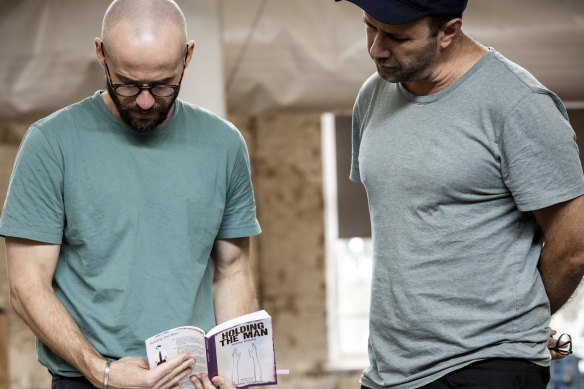
Tommy Murphy and the play’s director Eamon Flack during rehearsal. Credit: Brett Boardman
Adds Conroy: “It’s interesting because it’s like a real sticking point in their relationship that John is so devoted to Tim and Tim finds it so sort of suffocating and scary, and it makes him nervous because he wants other things and he wants to try being with other people.
“And that pattern happens time and time again. Things change once they both get HIV, but Tim still cheats on John and still lets him down. And then what’s beautiful about the book, and what Tommy Murphy has done with the adaptation of it, is that the whole writing of it, and performing of it, is a gift to John.
“And the way that Tim, once their relationship was really put to the test through both of them getting sick, and having to face their mortality and the fact they realised they had only so many days left with each other, that was what made him realise that actually, he had been in the midst of this greatest love story his whole life. And his devotion to John, beyond John’s death, became the thing that made his life make sense.”
That makes me even more sad.
“It’s so beautiful, so sad, and so romantic,” says Conroy, shaking his head.
Adds Ball: “People today talk about unconditional love, very openly and just kind of throw it around. But ultimately, love doesn’t have conditions. In the end, it is unconditional and it’s so beautiful to see.”
As for what they think a new younger audience, who didn’t come of age during the AIDS crisis, will make of it, Conroy believes it will hit home.
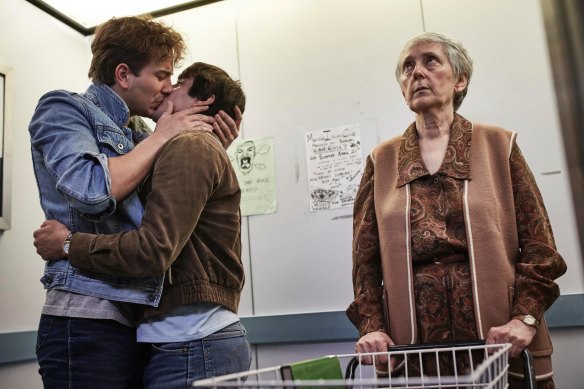
Ryan Corr, Craig Stott and Kerry Walker in the 2015 film adaptation of Holding the Man.
“It was only since I started working on this show that I realised how much I, and lots of gay men of my age, grew up in the shadow of the AIDS crisis in a way that we wouldn’t have really been conscious of. Tim died in ’94 and then the revolution to HIV medication happened in ’95, I think. So he just missed out.
“We grew up in the shadows kind of the Grim Reaper ad and, and the fear that our parents had ingested and the community did. And I think that’s part of the reason why I feel so close to it why and I think it will resonate so deeply with so many people in their late 20s and even older.
“For those of us who didn’t live directly through the crisis, we grew up through the trauma of it and it sits inside us in ways that I am only just realising.”
Holding the Man is at Belvoir St from March 9 to April 14.